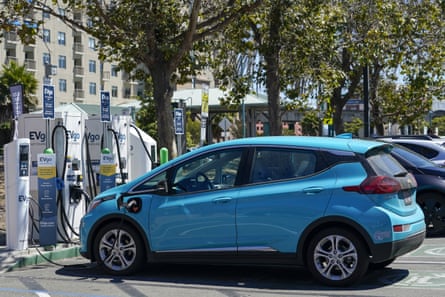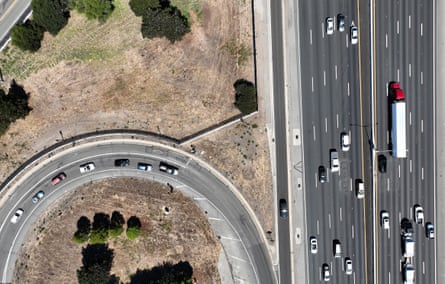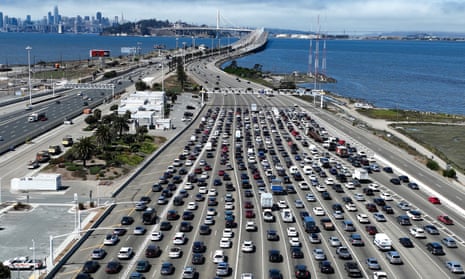California has approved a ban on the sale of new gasoline-powered vehicles by 2035 as the state takes dramatic steps to reduce emissions and combat the climate emergency.
In a vote on Thursday, state regulators moved forward with a plan to phase out the sale of gas cars over the next 13 years in America’s largest auto market.
The move is being hailed as a major victory that could point the way forward for others. It gives the most populous US state some of the world’s most stringent regulations for transitioning to electric vehicles.
“This is a historic moment for California, for our partner states, and for the world as we set forth this path toward a zero-emission future,” said Liane Randolph, chair of the California Air Resources Board (Carb), the regulatory board that voted on the plan.
“This is monumental,” said Daniel Sperling, a member of Carb, to CNN. “This is the most important thing that Carb has done in the last 30 years. It’s important not just for California, but it’s important for the country and the world.”
The policy allows Californians to keep driving gas-powered vehicles and buying used ones after 2035, but no new models would be sold in the state. It applies to all new cars, trucks and SUVs. The policy still needs federal approval but that’s considered very likely under Joe Biden’s administration.
The vote comes two years after the state’s governor, Gavin Newsom, issued an executive order requiring the sale of new cars to be zero-emission.
In 2021, only 12% of new cars sold in California were zero-emission, according to Carb, though about 16% of cars sold in the first three months of this year were electric. The new rule would require the state reach 35% of sales by 2026, 68% by 2030 and 100% by 2035. It would not affect cars that are already on the road.

The measure, Sperling said, will set an example to other states that often look to California when setting their own standards. Sperling told CNN the proposal faced “surprisingly little debate” and resistance from carmakers, which have ramped up production of electric vehicles. General Motors has said it plans to sell only electric vehicles by 2035.
But at a June meeting of the Carb, some automotive companies said the timeline of the state’s transition to electric vehicles would be difficult for the industry.
“There are very real challenges in meeting consumer demand for affordability, ease of charging, while at the same time overcoming existing global supply chain disruptions and limited access to critical minerals,” said David Barker with North American Subaru. “And all of these challenges are amplified for smaller manufacturers like Subaru.”
The Alliance for Automotive Innovation, which represents many major carmakers, said meeting the state’s ambitious timeline will be challenging due to the lack of charging infrastructure, access to materials needed for batteries and supply chain issues.
“These are complex, intertwined and global issues well beyond the control of either [Carb] or the auto industry,” said John Bozzella, the group’s president.
More than half of California’s carbon pollution comes from the transportation sector, Newsom pointed out when announcing his executive order in 2020. The governor has hailed the plan as a crucial step to address the climate emergency, which has fueled costly and destructive natural disasters in the state.
“This is the most impactful step our state can take to fight climate change,” Newsom said at the time. “Californians shouldn’t have to worry if our cars are giving our kids asthma. Our cars shouldn’t make wildfires worse – and create more days filled with smoky air. Cars shouldn’t melt glaciers or raise sea levels threatening our cherished beaches and coastlines.”
Research has shown a transition to electric cars would have substantial effects in the US, where transportation is the largest contributor to the country’s greenhouse gas emissions. A report released earlier this year by the American Lung Association found the US could save 110,000 American lives, $1.2tn in public health costs and reduce greenhouses gases by 92% by 2050 if it were to swap gas-powered vehicles for zero-emissions cars.

Despite Thursday’s vote, California’s transition to electric vehicles will take time as gas-powered cars will outnumber zero-emission vehicles for years. Gas vehicles bought today are expected to stay on the roads for decades. A 2020 study found that the US would have had to move to electric vehicle only sales in 2020 if it were to have an all-electric fleet by 2050.
“There’s an enormous amount of inertia in the system to overcome,” Abdullah Alarfaj, a graduate student at Carnegie Mellon University and lead author of the study, said to the New York Times.
California will need to expand public charging stations to accommodate the surge in electric vehicles. The state has about 80,000 stations in public places, far fewer than the 250,000 it wants by 2025, which will place greater demand on California’s grid.
“This is going to be a transformative process and the mandate for vehicle sales is only one piece of it,” said Mary Nichols, the former Carb chair.
Environmental groups have praised the state’s new rules while urging officials to ensure electric vehicles are accessible.
“California is once again leading the way by establishing commonsense standards that will transition to sales of all zero-polluting cars and light-duty trucks in the state. Given its unique air pollution woes and the risks to residents from climate-fueled wildfires, California desperately needs these rules to slash tailpipe pollution,” said Kathy Harris, a clean vehicles advocate with the Natural Resources Defense Council.
“But this cannot be the final step: state leaders must build on this action so traditionally marginalized communities benefit from the transition to clean vehicles.”
California and the federal government offer rebates to offset the cost of buying electric cars. The state’s new rules have incentives for carmakers to make used electric vehicles available to low- and middle-income people, but some experts say California hasn’t done enough.
The Associated Press contributed to this report
